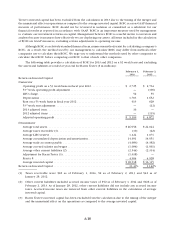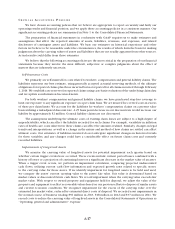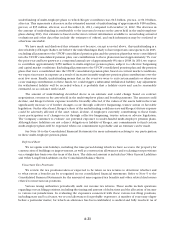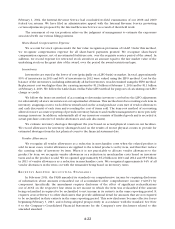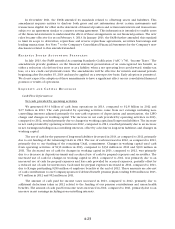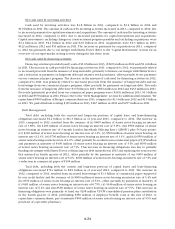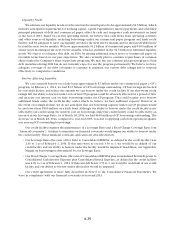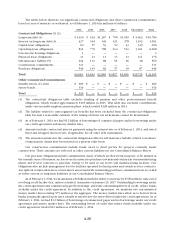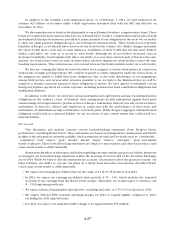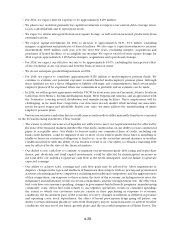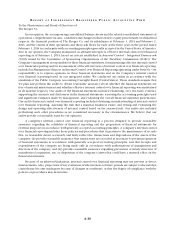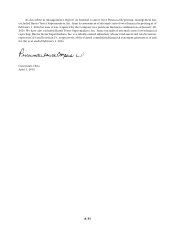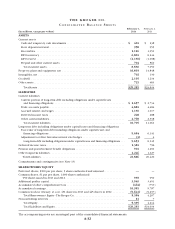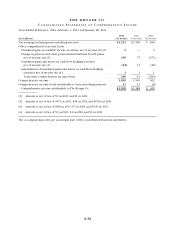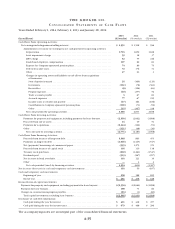Kroger 2013 Annual Report Download - page 98
Download and view the complete annual report
Please find page 98 of the 2013 Kroger annual report below. You can navigate through the pages in the report by either clicking on the pages listed below, or by using the keyword search tool below to find specific information within the annual report.A-25
Liquidity Needs
We estimate our liquidity needs over the next twelve-month period to be approximately $4.5 billion, which
includes anticipated requirements for working capital, capital expenditures, interest payments and scheduled
principal payments of debt and commercial paper, offset by cash and temporary cash investments on hand
at the end of 2013. Based on current operating trends, we believe that cash flows from operating activities
and other sources of liquidity, including borrowings under our commercial paper program and bank credit
facility, will be adequate to meet our liquidity needs for the next twelve months and for the foreseeable future
beyond the next twelve months. We have approximately $1.2 billion of commercial paper and $300 million of
senior notes maturing in the next twelve months, which is included in the $4.5 billion in estimated liquidity
needs. We expect to refinance this debt, in 2014, by issuing additional senior notes or commercial paper on
favorable terms based on our past experience. We also currently plan to continue repurchases of common
shares under the Company’s share repurchase programs. We may use our commercial paper program to fund
debt maturities during 2014 but do not currently expect to use the program permanently. We believe we have
adequate coverage of our debt covenants to continue to maintain our current debt ratings and to respond
effectively to competitive conditions.
Factors Affecting Liquidity
We can currently borrow on a daily basis approximately $2 billion under our commercial paper (“CP”)
program. At February 1, 2014, we had $1.2 billion of CP borrowings outstanding. CP borrowings are backed
by our credit facility, and reduce the amount we can borrow under the credit facility. If our short-term credit
ratings fall, the ability to borrow under our current CP program could be adversely affected for a period of time
and increase our interest cost on daily borrowings under our CP program. This could require us to borrow
additional funds under the credit facility, under which we believe we have sufficient capacity. However, in
the event of a ratings decline, we do not anticipate that our borrowing capacity under our CP program would
be any lower than $500 million on a daily basis. Although our ability to borrow under the credit facility is not
affected by our credit rating, the interest cost on borrowings under the credit facility could be affected by an
increase in our Leverage Ratio. As of March 28, 2014, we had $665 million of CP borrowings outstanding. The
decrease as of March 28, 2014, compared to year-end 2013, was due to applying cash from operations against
our year-end CP outstanding borrowings.
Our credit facility requires the maintenance of a Leverage Ratio and a Fixed Charge Coverage Ratio (our
“financial covenants”). A failure to maintain our financial covenants would impair our ability to borrow under
the credit facility. These financial covenants and ratios are described below:
• OurLeverageRatio(theratioofNetDebttoConsolidatedEBITDA,asdefinedinthecreditfacility)was
2.30 to 1 as of February 1, 2014. If this ratio were to exceed 3.50 to 1, we would be in default of our
credit facility and our ability to borrow under the facility would be impaired. In addition, our Applicable
Margin on borrowings is determined by our Leverage Ratio.
• OurFixedChargeCoverageRatio(theratioofConsolidatedEBITDAplusConsolidatedRentalExpenseto
Consolidated Cash Interest Expense plus Consolidated Rental Expense, as defined in the credit facility)
was 4.83 to 1 as of February 1, 2014. If this ratio fell below 1.70 to 1, we would be in default of our credit
facility and our ability to borrow under the facility would be impaired.
Our credit agreement is more fully described in Note 6 to the Consolidated Financial Statements. We
were in compliance with our financial covenants at year-end 2013.



